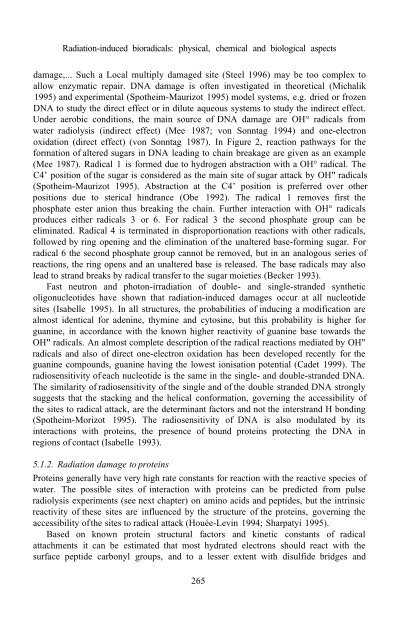Physics And Chemistry Basis Of Biotechnology - De Cuyper - tiera.ru
Physics And Chemistry Basis Of Biotechnology - De Cuyper - tiera.ru
Physics And Chemistry Basis Of Biotechnology - De Cuyper - tiera.ru
You also want an ePaper? Increase the reach of your titles
YUMPU automatically turns print PDFs into web optimized ePapers that Google loves.
Radiation-induced bioradicals: physical, chemical and biological aspects<br />
damage,... Such a Local multiply damaged site (Steel 1996) may be too complex to<br />
allow enzymatic repair. DNA damage is often investigated in theoretical (Michalik<br />
1995) and experimental (Spotheim-Maurizot 1995) model systems, e.g. dried or frozen<br />
DNA to study the direct effect or in dilute aqueous systems to study the indirect effect.<br />
Under aerobic conditions, the main source of DNA damage are OH° radicals from<br />
water radiolysis (indirect effect) (Mee 1987; von Sonntag 1994) and one-electron<br />
oxidation (direct effect) (von Sonntag 1987). In Figure 2, reaction pathways for the<br />
formation of altered sugars in DNA leading to chain breakage are given as an example<br />
(Mee 1987). Radical 1 is formed due to hydrogen abstraction with a OH° radical. The<br />
C4’ position of the sugar is considered as the main site of sugar attack by OH" radicals<br />
(Spotheim-Maurizot 1995). Abstraction at the C4’ position is preferred over other<br />
positions due to sterical hindrance (Obe 1992). The radical 1 removes first the<br />
phosphate ester anion thus breaking the chain. Further interaction with OH° radicals<br />
produces either radicals 3 or 6. For radical 3 the second phosphate group can be<br />
eliminated. Radical 4 is terminated in disproportionation reactions with other radicals,<br />
followed by ring opening and the elimination of the unaltered base-forming sugar. For<br />
radical 6 the second phosphate group cannot be removed, but in an analogous series of<br />
reactions, the ring opens and an unaltered base is released. The base radicals may also<br />
lead to strand breaks by radical transfer to the sugar moieties (Becker 1993).<br />
Fast neutron and photon-irradiation of double- and single-stranded synthetic<br />
oligonucleotides have shown that radiation-induced damages occur at all nucleotide<br />
sites (Isabelle 1995). In all st<strong>ru</strong>ctures, the probabilities of inducing a modification are<br />
almost identical for adenine, thymine and cytosine, but this probability is higher for<br />
guanine, in accordance with the known higher reactivity of guanine base towards the<br />
OH" radicals. An almost complete description of the radical reactions mediated by OH"<br />
radicals and also of direct one-electron oxidation has been developed recently for the<br />
guanine compounds, guanine having the lowest ionisation potential (Cadet 1999). The<br />
radiosensitivity of each nucleotide is the same in the single- and double-stranded DNA.<br />
The similarity of radiosensitivity of the single and of the double stranded DNA strongly<br />
suggests that the stacking and the helical conformation, governing the accessibility of<br />
the sites to radical attack, are the determinant factors and not the interstrand H bonding<br />
(Spotheim-Morizot 1995). The radiosensitivity of DNA is also modulated by its<br />
interactions with proteins, the presence of bound proteins protecting the DNA in<br />
regions of contact (Isabelle 1993).<br />
5.1.2. Radiation damage to proteins<br />
Proteins generally have very high rate constants for reaction with the reactive species of<br />
water. The possible sites of interaction with proteins can be predicted from pulse<br />
radiolysis experiments (see next chapter) on amino acids and peptides, but the intrinsic<br />
reactivity of these sites are influenced by the st<strong>ru</strong>cture of the proteins, governing the<br />
accessibility of the sites to radical attack (Houée-Levin 1994; Sharpatyi 1995).<br />
Based on known protein st<strong>ru</strong>ctural factors and kinetic constants of radical<br />
attachments it can be estimated that most hydrated electrons should react with the<br />
surface peptide carbonyl groups, and to a lesser extent with disulfide bridges and<br />
265












